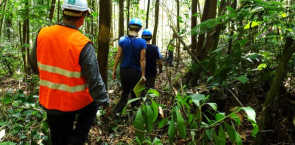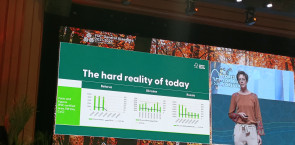
Companies facing new legal requirements as the EU Timber Regulation comes into force in March 2013 are looking for ways to reduce the risk of sourcing illegal material.
A pressing issue for many is the future status of certification schemes under the regulation. Third-party certification seems like a straightforward option if you have access to buying certified/verified products, and many stakeholders are therefore looking to the FSC and PEFC schemes to provide the risk mitigation required by EU.
At an earlier stage, it was discussed to set up a “green lane” for credible certification schemes, exempting certified products from risk assessment. This was not accepted and as a result only products carrying a FLEGT or CITES timber export license are exempt from the EU due diligence requirements.
However, while not endorsing any specific schemes, the EU acknowledges that certification schemes play an important role in due diligence efforts.
The regulation itself mentions certification and verification as tools for assessing and mitigating risks. Furthermore, the Implementing Regulation 607 released by EU on 6 July 2012 sets out criteria for certification schemes to be considered in this context.
EU requires such schemes to cover all relevant requirements of the applicable legislation; involve regular checks at a minimum frequency of once per year including field visits and verification of legal compliance; include third party verified tracing of legally harvested timber products throughout the supply chain; and include third party verified controls to exclude illegal timber and timber of unknown origin from the supply chain.
Future status of forest certification and legality verification schemes
Legality is considered a fundamental aspect of sustainable forest management, and the world’s largest certification schemes for responsible forestry, FSC and PEFC, naturally have requirements in place pertaining to legal harvesting.
Moreover, FSC and PEFC certification are accepted as proof of legal and sustainable timber under several European national public procurement policies.
Most stakeholders would therefore naturally assume that FSC or PEFC certification provides the legality assurance required by EU. But is this the case? NEPCon CEO Peter Feilberg explains:
“The reality is that there is no single established definition of illegal harvesting and that you can address the risk of illegal timber sourcing at several levels and in several ways. Some systems focus only on the legal right to harvest. Others apply a broader definition of ‘legal harvesting’ including legal requirements for health and safety precautions, environmental protection and third parties’ rights. The EU Timber Regulation uses a very broad legality definition including even trade and customs legislation”.
FSC and PEFC address legality in different ways, which is one of the reasons why PEFC material is not accepted as Controlled Wood in the FSC system. Depending on the exact scope of each system, forest certification systems may or may not provide the full range of assurance required by the EU.
The usefulness of a certification scheme for mitigating risk under the EU Timber Regulation largely hinges on the answers to the following questions:
1. Does the scope of legality covered by the standard fully cover the definition in the EU regulation?
2. Does the system address legal trade and customs requirements in the supply chain?
3. Does the system cover access to information about origin and species?
4. Is there a robust system in place to ensure that forest products from legal sources are not mixed or substituted with products from unknown or illegal sources through the supply chain?
5. Is there a robust assurance system in place for consistent enforcement of the established legality requirements at the forest level and in the supply chain?
When the regulation was published two years ago, no timber verification scheme fully addressed the broad legality definition applied by the EU; but some have worked to adjust their systems to the new European legality requirements.
Two years would seem like a long enough time; however, important clarifications were only provided in the Implementing Regulation released in July 2012, and resolution to other central questions is still pending a planned EU guidance document. Certification scheme owners are facing a dilemma, where efforts to provide optimal assurance under the regulation must be balanced by the need to avoid undue burdens on certificate holders.
What is FSC doing to ensure alignment?
FSC has taken important steps to address the regulation by strengthening its requirements for co-products and phasing out its exception regarding minor components, where up to 5% of the input for FSC products was allowed to come from unknown sources in FSC certified material. A recent self-assessment of the FSC system against the EU criteria concludes that the FSC scheme as such is eligible to be used for mitigating risk of illegal harvest, and identifies some areas that further need to be addressed.
Currently, FSC does not have a system in place for identifying the country of origin and the species involved, as required by the regulation. The FSC Controlled Wood Standard and the FSC Principles & Criteria are also not fully aligned with the EU requirements, e.g. customs and trade legislation is not addressed.
In addition, significant differences are found between the national FSC forest management standards regarding the types of legislation covered.
However, these gaps are not likely to remain in the system indefinitely. FSC has taken a string of actions, notably revision of the FSC Controlled Wood Standard, its chain of custody system, and development of generic requirements for forest management evaluations. A related initiative is the pending Online Claims Platform (OCP) which can contribute to meeting one of the hardest challenges of the timber regulation – having access to information on species and country of origin for any timber product placed on the EU market for the first time. According to FAQ recently released by FSC, the revised standards as well as the OCP are expected to be in place by mid-2013.
The organisation has released draft advice notes on two key issues for public comment: non-conforming products and information about origin and species. An advice note on minor components is pending finalisation.
In addition, FSC is seeking clarifications from the European Commission and aligning its national forest management standards in FLEGT countries with the legality requirements contained in the Voluntary Partnership Agreements (VPAs).
“When FSC has implemented the announced changes, I expect the FSC system will be well aligned with the EU requirements and definitions, and become an efficient tool for risk mitigation”, concludes Mr Feilberg.
What level of assurance will PEFC provide?
On 4 October 2012, PEFC announced that the PEFC chain of custody system will be revised in order to “satisfy information needs of legislative and regulatory processes such as the EU Timber Regulation, the US Lacey Act, and the Australian Illegal Logging Prohibition Bill”. PEFC states that appropriate requirements will be built into the PEFC Due Diligence System, an integral part of the PEFC chain of custody system. However, the organisation has not yet indicated what specific steps will be taken.
A report prepared by NEPCon and published by FSC on 15 May 2012 revealed several fundamental weaknesses in the PEFC chain of custody system that appear significant in the context of the EU requirements:
- The global PEFC Chain of Custody Standard uses a broad legality definition covering environmental and social legislation. However, PEFC’s procedures for risk evaluation of non-certified wood mixed into PEFC products are based on a much narrower definition focussing on the legal rights to harvest.
- Aside from its own global standard, PEFC also recognises other chain of custody standards that may apply different requirements or definitions regarding legality. For example, the Belarusian PEFC-endorsed CoC standard focusses only on legal logging rights.
- The exact definition and scope of legality are often not specified in national PEFC forestry standards.
The report also pinpointed major weaknesses in PEFC’s assurance system which may jeopardise the system’s overall ability to deliver its requirements in practice. “Legality requirements can be covered well on paper. However, robust assurance of legal harvesting requires efficient enforcement of scheme compliance on the ground. In our evaluation, the PEFC system is weak and in some cases dysfunctional in this aspect”, says Mr Feilberg.
Finally, the the PEFC system does not consistently cover access to information about species and country of origin. And the global PEFC definition of legality does not cover customs and trade legislation, which represents a gap compared to the EU Timber Regulation.
What about timber legality schemes?
Several voluntary timber legality verification schemes exist, such as the Rainforest Alliance VLC, SGS TLTV, OLB, SCS LegalHarvestTM, and Certisource, as well as new solutions such as NEPCon’s LegalSource programme.
As these schemes are catering to an emerging market, their market uptake is yet limited, but verified products may be considered as a way of addressing risk of illegal harvesting. As with forest certification, each scheme has its own legality definition and requirements; however, work is on-going to harmonise the systems. Among others, the LegalSource and Rainforest Alliance VLC standards are aligned with this process.
Mr Feilberg: “Along with other organisations, we are working towards a common framework for legality evaluation, in line with the definitions and requirements of regulations with significant market impact, such as the EU Timber Regulation, the US Lacey Act and the Australian Illegal Logging Prohibition Bill. Alignment will also be sought with the legality definitions used in the FLEGT/VPA processes".
“The current situation reflects that the market is in a state of transition. A forest of certification and verification schemes that need to be invidually assessed for each regulated market is not the optimal solution, neither seen from the industry perspective nor for achieving the goal of halting illegal timber harvesting", Mr Feilberg points out, adding: "I see an urgent need for a common legality definition as well as harmonised specific requirements and assurance procedures at the forest management level and for the supply chain”.






